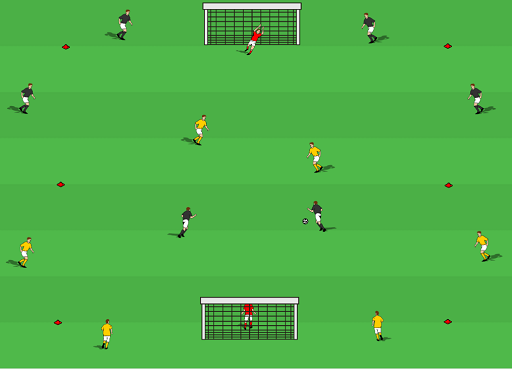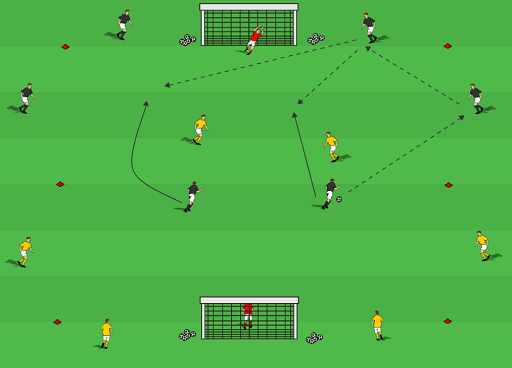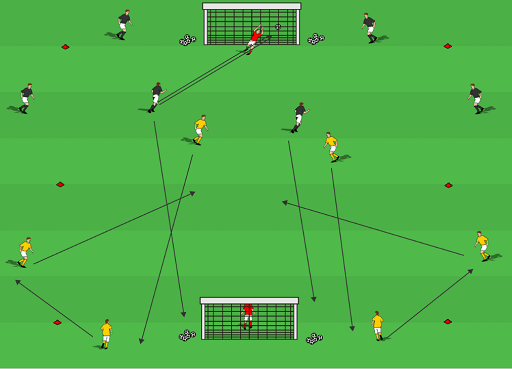- You are here:
- Home »
- General Coaching »
- Attacking Play and Finishing Around The Box
Attacking Play and Finishing Around The Box
By Gregg Gillies –
Set Up: Size (25 x 20 yards) at least 12 players plus 2 GK
The Drill: Two teams (black and yellow). Each team has 2 players on the field of play. Each team also has two players on the outside of the cones, on the offensive half only.
Both teams have two players on the endline, one on each side of the goal. These players are in the offensive half. In other words, as seen in diagram 1 below, the team in black is shooting on the goal that has their teammates standing next to the goal. Yellow is shooting on the goal with the the yellow players on the endline.
Play 2 v 2 in the middle with each team having 4 outside players they can pass to. Only the 2 players in the middle can score. Offensively speaking, the drill uses 6 attacking players similar to the front 6 of a 4-4-2 with the 2 in the middle being the central midfielders. The two out wide are the outside midfielders.
The two on the endline are like back to goal forwards. While having them on the endline is somewhat unrealistic the positives out way the negatives as there are a lot more scoring opportunities with them there. To help the players understand it visually, think of them as players who got endline and are playing cut back crosses.
Limit the outside players to one or two touches. With two touches the ball can’t stop moving. If they are skilled enough make it one touch.
Outside players can play to outside players.
Make sure there are a number of balls in each goal.
Winners stay on. Losers rotate. The 2 players on the field go to the endline. The two endline players rotate to the wide positions and the wide players move on to the field and play. See diagram 3 below.
The winners race back and grab a ball out of their own net and begin play. They do NOT wait for the yellow team to get organized.

This is a high tempo, competitive attacking game. As the players get used to the game, there should be a lot of shots and goals. In order to keep things moving, consider a time limit. If neither team scores in a minute, or 90 seconds or two minutes, make both teams rotate. Call out which team gets the ball.

Here is an example of combination play using the outside players.
Diagram 3 (This is the rotation example with the black team scoring)

The two players in black go back to get a ball out of their goal. For yellow, the players in the middle go to the endline. The endline players go out wide and the wide players come inside to defend.
Coaching Points
Finding shooting angles. Except for the younger age groups, almost anywhere on the field of play is a shooting opportunity, with only 25 yards from goal to goal. They don’t need to dribble by a player, they just need to use a fake or feint to create a shooting angle around the defender.
Making runs. The two players in the middle should never be standing still.
Variety of runs. It shouldn’t always be vertical runs up the field. The two players in the middle shouldn’t always be on one side of the field.
Using the outside players. Players, especially younger ones, have a tendency to ignore outside players or neutral offensive players, which negates the entire reason for having them. Encourage the 2 in the middle to use the outside players to help them create more chances.
High tempo
Communication
Quick combination play
Vision, awareness and anticipation. If players don’t get their heads up and think ahead, they will not be able to work together to create scoring opportunities. With the one touch restriction outside players must be anticipating and thinking ahead at all times.
Progression/Variation
Limit the outside players to one touch.
Have the outside players only play crosses instead of looking to make passes to feet. To facilitate an emphasis on crosses, maybe widen the field 5 yards on each side.
Progress to 4v4 in the middle. Increase the length of the field from goal to goal to a double box, 36 yards.
As the players get used to the drill and the rotation, this will become a high tempo attacking exercise with a lot of shooting and finishing for the players without them standing around in lines waiting for their turn.
By Gregg Gillies
Gregg Gillies is a nationally licensed coach through the USSF and is a Youth Athlete Development Specialist and Head Coach at Mount Laurel United Soccer Club, where he currently coaches a u14 girls team, the MLU Raptors. He also is the owner of www.NoLimitsSoccerTraining.com, where his focus is on maximizing a player’s individual technical skills, soccer IQ, and overall athletic development.
